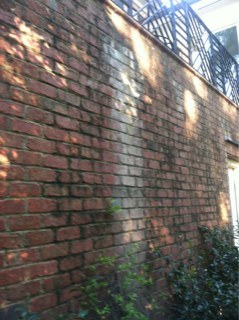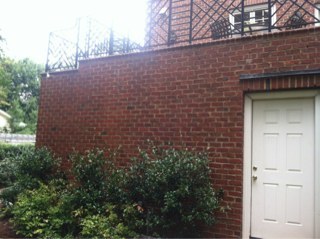I run into efflorescence on just about every job I do and am honestly tired of trying to get rid of it. I’ve tried numerous types of cleaners to no avail. I was wondering if there was anything revolutionary in this field that has proven good results? When I say good results I mean time effective as well.
Here are pictures of different homes with the same issues:
Hey Haim-- efflorescence is always a pain to deal with. It’s the salts leaching thru the brick. It can be so deep at times that it can go all the way thru the brick. I deal with efflorescence alot when we clean split face block type bldgs such as what you see the home depot bldgs are made of.
A company we used products from in the past is Prosoco PROSOCO, Inc. - Mobile
I hate to say this but we set “low” expectations" with our customers when it come to efflorescence. We tell our customers that some of the efflorescence may lighten but there’s no way of telling that until we clean the siding. We guarantee the brick siding will be cleaned to there liking but once again the efflorescence we guarantee nothing there.
Hardest thing to clean/remove is efflorescence from my experiences because its coming from the inside out.
Good luck.
Hey John! Thanks for replying. I’ve resulted in doing the same regarding the efflorescence and set low customer expectations. Interstingly enough I dont really see it on the walls of the house only on steps, porches and other detatched structures, even when the house is right on the beach where there is salt in the air. I’ve also spoken to the top brick layers around here who have told me the same thing and there’s really nothing to do about it. It’s a shame, I know people willing to drop small fortunes to get rid of it, if only there was a solution.
When removing the white stuff ALWAYS do a thorough test area before you price any job and decide what you’re cleaning it with. The white stuff may not be efflorescence when it could be Calcite, lime run, white scum etc. Like John said, set low expectations, it can be real tricky. Also pay attention to your dilution ratios and temperature.
In the second picture (steps) that looks like a mix of Calcite and Lime Run for example. Almost 100% sure on that. Thicker deposits are going to take heavier applications and longer dwells.
EaCo Chem has a few products for the removals. EF-Fortless, Calcite Presoak, White Scum Presoak, NMD-80 as well as One Restore
EaCo Chem Inc. Cleaning and Restoration Compound Manufacturer
OneRestore.
Sent from my iPhone using Pressure Washing Resource mobile app
It’s trial and error with efflorescence. I seen the stuff come right out(rare) and seen it not budge no matter what. We also cleaned Brick houses where maybe because we cleaned it the efflorescence looked worse because the brick was so bright so it stood out more.
If there is one thing I hate the most-- it’s dealing with “The white stuff” on brick/block.
It’s really a science removing the white stuff, I’ve tried the one restore on the last picture above and let it dwell for about 30 min not letting it dry and it stayed the same, didn’t budge. I’ve also tried an acid for efflorescence and got zero results. It’s very difficult when it comes to dwell time cause I’m scared to do some irriversible damage so I stay away from playing hero. I will add some of these products to my arsenal in hopes to find a solution. There was one time where the one restore helped that was the only time out of 7 different cases that it worked.
What I don’t get is how come the brick manufacturers don’t have the answer to this, you have a person dropping 300k on bricks only to have white stuff grow out of it 12 months later??
A failed sealer has close to the same look as the last picture.
One way to tell is acid will foam up and have a reaction with the alkaline surface. If there is a sealer on top, it will block the acid and you won’t see a reaction.
Then you just have to do process of elimination on trying to remove failed sealer, which isn’t fun.
Funny you mention that… There was no reaction to the acid
Yup, not OneRestore’s fault…
Now it depends on what kind of sealer it is. We came up on a brick sign that had the same symptom. Used high level alkaline, caustics, Stripper Cream from EaCo Chem (Multi-layered paint/coating remover) and that wouldn’t even budge it. (Used LONG dwell times even, keeping wet from and hour up to 24hrs of dwell on the cream)
End result we couldn’t remove the sealer and didn’t want to run the risk of using anything harsh. So we stopped there. It had previously been cleaned with Muratic or Hydrofluoric (we found out) that had damaged the surface. Pretty much the next option was TNT.
Here’s a good read that covers the basics and to help troubleshoot what you have there.
Wow! I can’t believe what you’re telling me, that’s nuts.// Thank you so much, this ^^^ is definitely gonna make my life easier
Good question Haim. Theres a ton of money to be made in sealing brick structures. Probably a good sealer can help prevent the efflorescence from happening because moisture helps brings the salts thru the brick-- problem though is people dont want to pay for this service.
Then on the flip side if the moisture comes from the inside and wicks out, then you have to work around the sealer.
What we figured with that sign we did, is that the brick was sealed and the precast caps were not (precast had 100% reaction with the acid) Allowing moisture inside the wall.
I like where you’re going with this, it could be that if a new home owner is educated about the nature of the brick and how he can protect his investment he may pay the extra money and have it sealed…and if he isn’t interested so then you’ll see him in 6-8 months for a maintenance clean.
Trey, or someone else, I read the article on Eaco Chem’s site so I was curious how do you deal w/ White Scum? And how do you test for it? i.e.: how do you know the difference between Calcite, Lime run, White Scrum?
Eric
Best way to find out is just to test it.
Efflorescence is generally powdery. Calcite is a hard brittle mineral, can be thick or thin. Lime run is usually flat and kinda “runs”. Calcite and lime run is the same removal process. White scum I haven’t dealt with personally.
Before and after picture that I used Onerestore on. Sprayed on and kept wet until dissolved.
It took a couple hours to rid it completely.
Sent from my iPhone using Pressure Washing Resource


